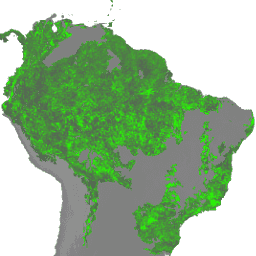
- Disponibilidad del conjunto de datos
- 2012-01-01T00:00:00Z–2019-04-23T00:00:00Z
- Proveedor de conjuntos de datos
- World Resources Institute / Global Forest Watch
- Etiquetas
Descripción
NOTA del WRI: El WRI decidió dejar de actualizar las alertas de FORMA. El objetivo era simplificar la experiencia del usuario de Global Forest Watch y reducir la redundancia. Descubrimos que Terra-i y GLAD se usaban con mayor frecuencia. Además, al usar GLAD como estándar, se descubrió que Terra-i superó a FORMA a nivel mundial.
Las alertas de FORMA se detectan con una combinación de dos productos de MODIS: el NDVI (índice de vegetación de diferencia normalizada) y FIRMS (Fires Information for Resource Management System). Las actualizaciones del NDVI se procesan cada 16 días, mientras que las de incendios se procesan a diario. Los modelos se desarrollan de forma individual para cada ecogrupo con el objetivo de relacionar las dos entradas con el área de deforestación, y se usan los datos anuales de pérdida de cobertura arbórea de Hansen para entrenar el modelo. El umbral mínimo para calificar como alerta es el 25% de los píxeles despejados, aunque los umbrales varían según el grupo ecológico para minimizar los falsos positivos. Aquí tienes un ejemplo de secuencia de comandos para una introducción rápida a los conjuntos de datos de FORMA.
Las imágenes de esta ImageCollection contienen las "estadísticas t rectificadas invertidas" que se usan para calcular el NTT, el índice de color de la vegetación derivado del NDVI de MODIS que FORMA usa para medir el pardeamiento. Si se usa un reductor de suma en varios períodos de esta ImageCollection, se produce una imagen de "NTT".
Las imágenes se desglosan por "ecogroup".
Bandas
Tamaño del píxel
250 metros
Bandas
| Nombre | Mín. | Máx. | Tamaño de los píxeles | Descripción |
|---|---|---|---|---|
tstat_r |
0* | 25.41* | metros | Estadísticas t invertidas y rectificadas, es decir, (máx.(0, -t_stat)). |
Propiedades de imágenes
Propiedades de la imagen
| Nombre | Tipo | Descripción |
|---|---|---|
| año | INT | Año de los datos más recientes incluidos en el conjunto de datos |
| quincenal | INT | El período quincenal (cada 16 días) del año |
| ecogroup_id | STRING | ID del grupo ecológico asociado |
Condiciones de Uso
Condiciones de Uso
Los conjuntos de datos de FORMA están disponibles sin restricciones de uso ni distribución. El WRI solicita que el usuario proporcione la atribución adecuada y que identifique al WRI y a GFW, cuando corresponda, como la fuente de los datos.
Explora con Earth Engine
Editor de código (JavaScript)
var dataset = ee.ImageCollection('WRI/GFW/FORMA/vegetation_tstats') .filter(ee.Filter.date('2018-07-01', '2018-07-15')); var tstat = dataset.select('tstat_r'); var visParams = { min: 0, max: 1, }; Map.setCenter(26, -8, 3); Map.addLayer(tstat, visParams, 'Reversed rectified t-statistics');
